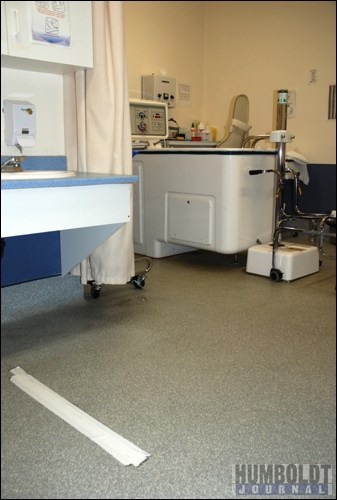The final report is in on the floor situation in Dust Wing of St. Mary's Villa, but no decision on how to fix it has yet been made.
Walter P. Moore Limited issued the final engineering report on the trusses supporting the floor in this wing of the Villa to Saskatoon Health Region (SHR) on March 1.
It indicates that the floor of the wing, built in 1975, is definitely compromised.
A preliminary engineering report on the wing's flooring stated much the same thing, and prompted the SHR to make plans to move the 32 residents of Dust Wing into other parts of the building. Use of a sunroom and dining room in the wing will also be discontinued until the floor structure issues are addressed.
This wing of the Villa is the only one with wooden floor trusses - the rest of the building sits on concrete foundations.
In their comprehensive structural review of the floor trusses at the Villa, Walter P. Moore Limited engineers examined the trusses visually, and took out wood cores from the floor deck at places throughout Dust Wing in order to better understand the composition of the flooring system.
A number of conditions, including longitudinal splits in the bottom truss chords, isolated splits in the top truss chords, through-thickness fractures in trusses below the tub rooms, which are shored, crawl spaces with damp subsurface conditions and unbonded floor decking through the Dust Wing area.
All these conditions, the report states, appear to have compromised the load carrying capacity of the top and bottom chords of trusses - a reduction that varies "from five per cent to 75 per cent depending on the severity of the split and its orientation."
Floor trusses in the main corridor and dining room were also found to be insufficient to limit the potential for perceivable movement by occupants, or to damage things like floor and wall finishes or things like plumbing lines connected to the structure.
The capacity of the wood framing has also been impacted, the report states, by the moisture content in the wood.
What the engineers concluded was that the undamaged floor trusses throughout Dust Wing appear to have the capacity to safely support the original design loads, which were 40 lbs per square foot in patient rooms and adjacent hallways, and 100 lbs per square foot in the dining area and main central lobby.
However, floor trusses in the main central corridor and dining room did not meet criteria for a live load of 100 lbs per square foot.
The SHR has reported that the entire wing, which now contains Levels 3 and 4 care patients instead of the Levels 1 and 2 patients the wing was designed for, was carrying about 100 lbs per square foot, due to things like new bathtubs and lifts required for residents needing high levels of care.
The report gave the SHR a list of high and medium level priority recommendations to allow the building to continue to function as a Level 3 and 4 care facility.
High priority items, to be done immediately (within 30 days), included shoring trusses, repairing splits in trusses using metal plates or fasteners, and repairing through-thickness fractures in some of the trusses, through the use of metal plates or sistered lumber.
Of medium priority - to be done within six to 12 months - were retrofitting the floor trusses in the central corridor and dining room to make them stronger, strengthening and stiffening the plywood floor decking to decrease movement, and maintaining dry conditions for the wooden floor joists and decking in the crawl spaces by dehumidification.
The SHR has not made a decision about how to proceed with the repairs to Dust Wing quite yet. They are presently examining options, the SHR stated.
Once the options are examined, the SHR will make a recommendation to their board and the Ministry of Health.
In the meantime, residents of Dust Wing were to be moved into other parts of the Villa by the end of March.




